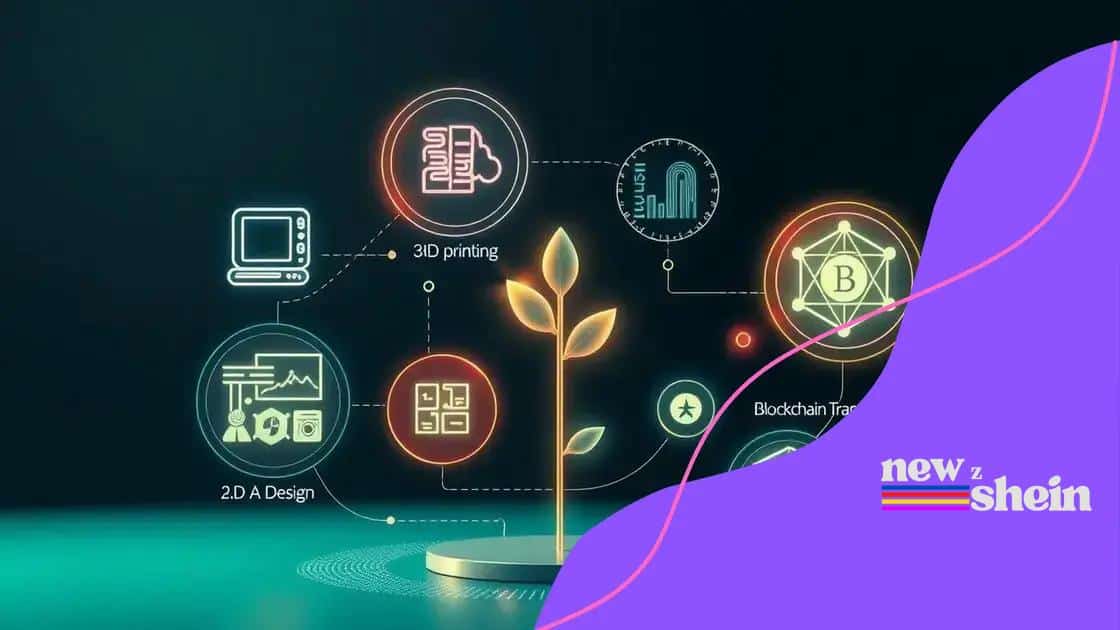Shein’s sustainability goals for 2030: what to expect

Shein’s sustainability goals for 2030 include achieving carbon neutrality, reducing water usage, and enhancing supply chain practices, while addressing consumer expectations and regulatory pressures.
Shein’s sustainability goals for 2030 are setting a new standard in fast fashion. As consumers become more eco-conscious, Shein aims to tackle the challenges of sustainability in the industry. What changes can we expect in the coming years?
Understanding Shein’s current sustainability efforts
Understanding Shein’s current sustainability efforts is crucial in the context of the fast fashion industry. Shein has been actively working to improve its practices and engage in a more responsible production process. By focusing on sustainability, the brand aims to reduce its environmental impact and address growing consumer concerns.
Current Initiatives
Shein has made significant progress through various initiatives. These efforts include:
- Sourcing sustainable materials: The brand is investing in eco-friendly fabrics to minimize resource use.
- Reducing waste: Efforts are in place to streamline production and minimize excess inventory.
- Transparency: Shein is enhancing its supply chain transparency to build trust with consumers.
Moreover, the brand is implementing measures to decrease its carbon footprint. For example, Shein is exploring energy-efficient manufacturing processes to lower energy consumption during production. This not only benefits the environment but also helps in reducing operational costs.
Consumer Engagement
Engaging consumers is key to Shein’s sustainability goals. The brand has launched campaigns that encourage customers to be part of the solution. Initiatives such as recycling programs and sustainable shopping guides are designed to raise awareness. By educating customers about responsible consumption, Shein aims to create a more environmentally conscious community.
Furthermore, Shein encourages feedback from its audience. This approach allows the company to adapt its practices based on consumer insights, fostering a collaborative relationship. Consumers are becoming more informed and seeking brands that value sustainability.
Ultimately, understanding Shein’s efforts in sustainability is vital for consumers who want to make informed choices. By prioritizing sustainable practices, Shein is working towards a future where fashion and environmental responsibility coexist.
Key sustainability targets for 2030
Shein’s key sustainability targets for 2030 are ambitious and reflect the brand’s commitment to creating a more environmentally friendly fashion industry. By setting measurable objectives, Shein aims to reduce its environmental impact while still catering to consumer needs.
Target Areas
To achieve its goals, Shein is focusing on several crucial target areas:
- Carbon neutrality: The brand aims to attain net-zero carbon emissions by 2030.
- Water management: Shein plans to minimize water usage in its production processes significantly.
- Waste reduction: The company is committed to reducing waste through improved manufacturing efficiencies and recycling initiatives.
These targets are part of a broader strategy to incorporate sustainable practices into every aspect of the business. Shein is continuously exploring innovative solutions to meet these objectives. For instance, they are investing in renewable energy sources and improved logistics to further reduce their carbon footprint.
Community Impact
Beyond environmental goals, Shein also focuses on community engagement and social responsibility. The brand aims to support local communities by introducing programs that promote sustainable living. This could include educational initiatives that teach consumers about sustainable fashion choices.
Moreover, Shein is collaborating with various stakeholders to enhance its sustainability efforts. Partnerships with environmental organizations and industry leaders are essential for achieving these targets. By working together, they can share best practices and create a unified approach towards sustainability in the fashion sector.
It’s important to monitor the progress of these initiatives. Transparency in reporting will help consumers stay informed about Shein’s journey toward its sustainability goals. Regular updates will show how the brand is evolving to meet its commitments to the planet and its community.
The role of technology in achieving sustainability

The role of technology in achieving sustainability is becoming increasingly important, especially for brands like Shein. Technology can help streamline processes and create innovative solutions to reduce environmental impact. By leveraging advancements in technology, Shein is aiming to enhance its sustainability efforts significantly.
Innovative Solutions
One way technology aids sustainability is through improved materials and production processes. For instance, Shein is exploring:
- 3D printing: This technology can reduce waste and create products on demand.
- AI in design: Artificial intelligence helps create designs that are more resource-efficient.
- Sustainable sourcing: Technology can track and verify the source of materials to ensure they meet sustainability standards.
These innovations not only reduce the environmental footprint but also improve efficiency. By adopting such technologies, Shein is able to meet customer demands while adhering to its sustainability goals.
Data Analytics
Data analytics plays a crucial role in monitoring sustainability practices. Shein can track its performance metrics to understand its impact on the environment. By analyzing data, the brand can pinpoint areas for improvement, ensuring it is on the right path toward its sustainability targets.
Technology allows for real-time feedback, enabling quick adjustments to production processes. This responsive approach ensures that Shein can adapt to changing demands and continuously improve its sustainability efforts.
Furthermore, utilizing blockchain technology can enhance supply chain transparency. By openly sharing information about the sourcing and production processes, Shein can build trust with consumers, creating a more responsible brand image.
Challenges Shein may face by 2030
Challenges Shein may face by 2030 in achieving its sustainability goals are significant and multifaceted. As the fashion industry evolves, Shein must navigate various hurdles to align with its ambitious objectives.
Regulatory Pressure
One challenge is increasing regulatory scrutiny regarding environmental practices. Governments worldwide are implementing stricter regulations on sustainability. Shein will need to adapt to these changes while ensuring compliance, which may increase operational costs.
- New laws: Regulations may require detailed reporting on sustainability efforts.
- Compliance costs: Adapting to new regulations could lead to increased expenses.
- Penalties: Non-compliance could result in fines that impact the bottom line.
This pressure may push Shein to improve transparency and enhance its sustainability initiatives more quickly than anticipated.
Consumer Expectations
Another significant challenge is the rising consumer expectations for sustainability. Today’s shoppers are more informed and demand greater accountability from brands. As Shein strives to enhance its sustainability profile, it must consistently meet these evolving consumer demands.
Failing to engage consumers effectively could lead to a loss of market share. To prevent this, Shein must invest in communication strategies that highlight its sustainable practices. Engaging customers in the sustainability journey can foster loyalty and trust.
Supply Chain Complexities
The complexity of supply chains is a further challenge. Shein’s fast fashion model relies on a vast network of suppliers. Ensuring that all partners adhere to sustainable practices can be difficult.
This involves:
- Monitoring: Maintaining oversight over supply chain operations is difficult yet necessary.
- Supplier compliance: Ensuring all suppliers meet sustainability standards can be challenging.
- Logistics: Sustainable logistics practices must also be implemented to minimize environmental impact.
Addressing these challenges will require resources, commitment, and collaboration to achieve meaningful progress toward sustainability goals.
Consumer response to Shein’s sustainability initiatives
Consumer response to Shein’s sustainability initiatives plays a crucial role in shaping the brand’s future. With a growing emphasis on eco-friendly practices, many shoppers are becoming more aware of their purchasing decisions.
Understanding Concerns
As Shein promotes its sustainability efforts, consumers are increasingly interested in understanding the real impact of these initiatives. Many shoppers seek transparency to ensure that claims about sustainability are genuine and not just marketing tactics.
- Trust: Building trust with consumers is essential for Shein to succeed.
- Transparency: Clear communication about sourcing and production processes is vital.
- Authenticity: Genuine efforts are expected, not just superficial changes.
Consumers are more likely to support brands that show real commitment to sustainable practices, reflecting a shift in values across the marketplace.
Customer Engagement
Engaging with customers around sustainability can enhance loyalty. Shein has the opportunity to connect with its audience through interactive campaigns, educating them on sustainable practices. For instance, initiatives that encourage recycling and responsible consumption can resonate well with eco-conscious shoppers.
Creating a dialogue with consumers about sustainability fosters greater understanding and involvement. This engagement can lead to a community that supports the brand’s goals and communicates its efforts further.
Impact on Purchasing Decisions
Moreover, consumer response directly influences purchasing behavior. Many shoppers now prioritize sustainability in their buying choices. Individuals want to feel good about their purchases and align them with their values.
As a result, Shein needs to adapt to this demand for sustainability. Offering sustainable options and communicating these effectively can drive sales and enhance the brand’s reputation.
Ultimately, positive consumer feedback on Shein’s sustainability efforts can lead to a stronger market position. Listening to the audience and making necessary adjustments will be key to the brand’s continued success.
FAQ – Frequently Asked Questions about Shein’s Sustainability Initiatives
What are Shein’s primary goals for sustainability by 2030?
Shein aims to achieve carbon neutrality, reduce water usage, and enhance its supply chain practices by 2030.
How does consumer feedback impact Shein’s sustainability initiatives?
Consumer feedback is vital as it helps Shein understand customer expectations and make necessary adjustments to its sustainability practices.
What challenges does Shein face in its sustainability efforts?
Shein faces challenges such as regulatory pressure, rising consumer expectations, and complexities in maintaining a sustainable supply chain.
How can consumers engage with Shein’s sustainability efforts?
Consumers can engage by providing feedback, participating in campaigns, and choosing sustainable products offered by Shein.





